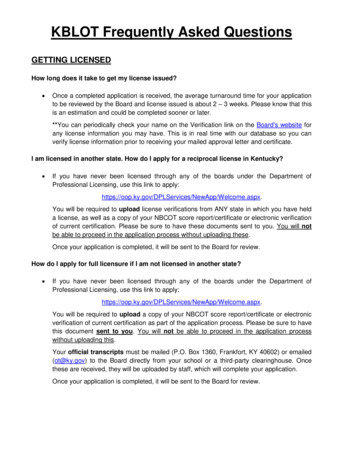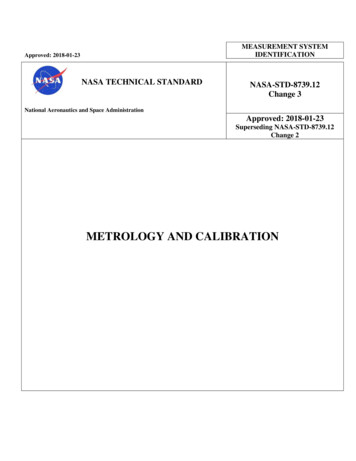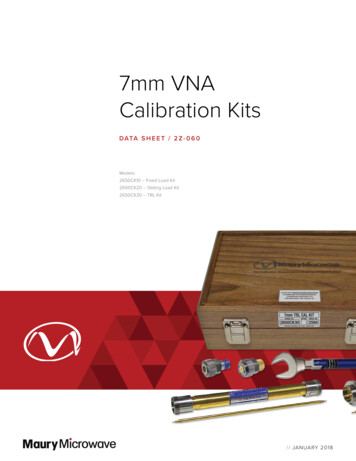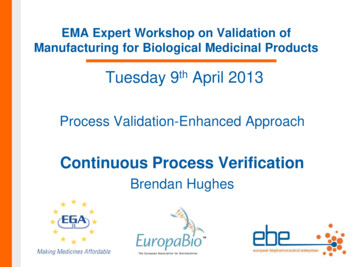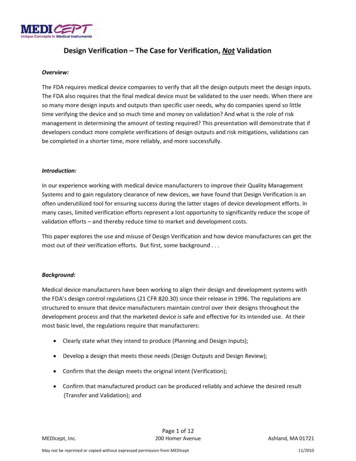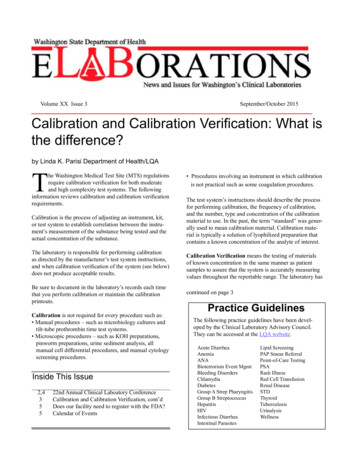
Transcription
Volume XX Issue 3September/October 2015Calibration and Calibration Verification: What isthe difference?by Linda K. Parisi Department of Health/LQAThe Washington Medical Test Site (MTS) regulationsrequire calibration verification for both moderateand high complexity test systems. The followinginformation reviews calibration and calibration verificationrequirements.Calibration is the process of adjusting an instrument, kit,or test system to establish correlation between the instrument’s measurement of the substance being tested and theactual concentration of the substance.The laboratory is responsible for performing calibrationas directed by the manufacturer’s test system instructions,and when calibration verification of the system (see below)does not produce acceptable results.Be sure to document in the laboratory’s records each timethat you perform calibration or maintain the calibrationprintouts.Calibration is not required for every procedure such as: Manual procedures – such as microbiology cultures andtilt-tube prothrombin time test systems. Microscopic procedures – such as KOH preparations,pinworm preparations, urine sediment analysis, allmanual cell differential procedures, and manual cytologyscreening procedures.Inside This Issue2,435522nd Annual Clinical Laboatory Conference Calibration and Calibration Verification, cont’dDoes our facility need to register with the FDA?Calendar of Events Procedures involving an instrument in which calibrationis not practical such as some coagulation procedures.The test system’s instructions should describe the processfor performing calibration, the frequency of calibration,and the number, type and concentration of the calibrationmaterial to use. In the past, the term “standard” was generally used to mean calibration material. Calibration material is typically a solution of lyophilized preparation thatcontains a known concentration of the analyte of interest.Calibration Verification means the testing of materialsof known concentration in the same manner as patientsamples to assure that the system is accurately measuringvalues throughout the reportable range. The laboratory hascontinued on page 3Practice GuidelinesThe following practice guidelines have been developed by the Clinical Laboratory Advisory Council.They can be accessed at the LQA website.Acute DiarrheaLipid ScreeningAnemiaPAP Smear ReferralANA Point-of-Care TestingBioterrorism Event MgmtPSABleeding DisordersRash IllnessChlamydiaRed Cell TransfusionDiabetes Renal DiseaseGroup A Strep Pharyngitis STDGroup B StreptococcusThyroidHepatitis TuberculosisHIV UrinalysisInfectious DiarrheaWellnessIntestinal Parasites
2 ELABORATIONS22nd Annual Clinical Laboratory ConferenceThe 22nd annual Clinical Laboratory Conference will beheld on November 9, 2015, at Foster Links Golf Course inTukwila. This is an excellent opportunity to hear about thestatus of health care from a variety of experts.Dennis Weissman, president of Dennis Weissman & Associates, LLC, in Washington, D.C., is the keynote speakerfor the Conference. He is presenting “More UpheavalAhead for the Laboratory Market: What to Expect FromNew Payment and Regulatory Initiatives.” Driven bya combination of macro market trends such as the shifttoward a value-based reimbursement environment, and thelegal affirmation of the Affordable Care Act, healthcareproviders including clinical laboratories find themselves atan inflection point when it comes both to the delivery andpayment of services for Medicare and Medicaid as well asfor commercial payers.For clinical laboratories, the advent of Medicare bundlingpayment for hospital outpatient pathology services waseffective earlier this year. This follows the packaging ofmost outpatient lab services that began in 2014. In themeantime, the Protecting Access to Medicare Act of 2014(PAMA) authorized the use of private payer rates to repricenearly all lab tests on the Medicare Part B Clinical Lab FeeSchedule effective in 2017 with labs required to turn overprivate payer pricing data to the government beginningELABORATIONS is a free monthly publication of theWashington State Department of Health (DOH) PublicHealth Laboratories (PHL) and Office of LaboratoryQuality Assurance (LQA).Secretary, DOH: John Weisman, DrPH, MPHHealth Officer: Kathy Lofy, MDDirector, PHL: Romesh Gautom, PhDProgram Manager, LQA: Susan WalkerEditor: Leonard KargacinCirculation: Leonard KargacinComments, letters to the editor, information for publication, and requests for subscription can be directed to:ELABORATIONS1610 NE 150th StShoreline, WA 98155e-mail address: leonard.kargacin@doh.wa.govNOTE: Letters to the editor may be published unlessspecified otherwise by the author.Website access:Department of HealthLaboratory Quality AssurancePublic Health Laboratoriesnext January. Future regulatory deadlines and implementation dates for PAMA were thrown in doubt when CMS waslate in issuing proposed guidance on the pricing initiative.The latest developments affecting implementation ofPAMA, as well as other reimbursement and regulatorychanges affecting lab and pathology services, includingthe Food and Drug Administration’s draft guidance onlaboratory-developed tests (LDTs), will be detailed in thispresentation. The speaker will also identify key macrohealthcare trends and discuss how they are driving transformational changes in the lab marketplace.Clinical and Public Health Microbiology - A Tsunami ofChange: Culture Independent Diagnostic TestingJames Besser, PhD, is the deputy chief, EntericDiseases Laboratory Branch at the Centers for DiseaseControl and Prevention in Atlanta. He will present “Clinical and Public Health Microbiology: ATsunami of Change.” A new generation of nucleicacid-based culture-independent diagnostic test (CIDT)panels is being introduced that can simultaneouslydetect multiple disease agents in just a few hours.The diagnostic microbiology landscape will likely befurther altered by metagenomics and point-of-caretesting in the not-too-distant future. These trends willsignificantly affect public health programs that dependon clinical laboratory data. This presentation will describe these trends and focus on strategies being takenby public health programs to adapt to the emergingnew diagnostic world.Xuan Qin, PhD, is the Microbiology Division chief atSeattle Children’s Hospital. She will present “Experience from Seattle Children’s Hospital: AdoptingRapid Molecular Assay Systems for the Diagnosis ofInfectious Diseases.” CIDT targeting a broad range ofinfectious agents simultaneously are able to providehighly sensitive results with one to four hours. Manyof the mega-multiplex syndromic panels have becomewidely available to clinical laboratories. While therapid CIDT have revolutionized the diagnosis of infectious diseases with obvious patient care and publichealth significance, the scope of utilization and costconsideration have to be evaluated before and afterimplementation.continued on page 4
3 ELABORATIONSCalibration & Calibration Verification, cont’d from page 1always been responsible for calibration verification or “checking” calibration for moderate or high complexity testing.Be sure to document in the laboratory’s records each time that you perform calibration verification and maintain those records.Calibration verification must be completed at least every six months or more frequently if specified in the test system’sinstructions and whenever any of the following occur: When there is a complete change of reagents such as new lot number, unless the laboratory can demonstrate that changingreagent lot numbers does not affect the range used to report patient results, and control values are not adversely affected byreagent lot number changes. Also when a different manufacturer is introduced, calibration verification needs to be done. There is major preventative maintenance or replacement of critical parts that may influence the test’s performance. Thisincludes when the laboratory sends a test system to the manufacturer for repairs. The laboratory must check the calibrationof the repaired test system before resuming patient testing and reporting results. Control materials reflect an unusual trend or shift, or are outside of the laboratory’s acceptable limits, and other means ofassessing and correcting of unacceptable control values fail to identify and correct the problem. The laboratory has determined that the test system’s reportable range for patient test results should be checked more frequently.Reminder: The laboratory is responsible for verifying calibration on factory-calibrated test systems that cannot be calibratedby the user.A variety of materials with known concentrations may be used to verify calibration. Examples include: proficiency testingsamples with known values, patient specimens with known values, or commercially available standards, calibrators, or control materials with known values (i.e. manufacturer’s assayed values). For these materials, the laboratory must define acceptable limits for the difference between the measured values obtained, versus the actual concentration of the materials. It is notacceptable to use currently in-use calibrators or controls.Because the purpose of calibration verification is to check whether the test system is providing accurate results throughoutthe reportable range, three levels must be tested (one at the high range of the reportable range, one at the low end of thereportable range, and one near the midpoint of the reportable range).If the instrument is factory–calibrated, consult with the manufacturer of the test system.There are some exceptions to the calibration verification requirement as listed below: Automated cell counters meet calibration verification requirements if the laboratory follows the manufacturer’s instructionsfor instrument operation, and tests two levels of control materials each day of testing, provided the control results meet thelaboratory’s criteria for acceptability. If the test system’s calibration procedure includes three or more levels of calibration material, and includes a low, mid, andhigh value, and is performed at least once every six months, then the requirement for calibration verification is also met.If calibration verification results are unacceptable, you must repeat the test system’s calibration procedure. After repeatingthe calibration procedure, the lab must run controls before resuming patient testing. If the test system is factory-calibrated,consult with the manufacturer of the test system.Further information about the MTS/CLIA requirements pertaining to calibration and calibration verification can be found atthe following websites: Refer to Table 90-2 in the MTS WAC available at the LQA website, Refer to the CMS CLIA Appendix C – Interpretive Guidelines Calibration and Calibration Verification Procedures(493.1255). Refer to the the CMS CLIA Brochure #3 - Calibration and Calibration Verification.
4 ELABORATIONS22nd Annual Lab Conference, cont’d from page 2The Washington State One Health Initiative and Antibiotic StewardshipPeter Rabinowitz, MD, MPH, is an associate professor at the University of Washington School of Public Health andSchool of Medicine. He will present “The Washington State One Health Initiative.” This presentation will review theemerging concept of One Health and how Clinical Laboratories play a critical role in One Health efforts. It will providean update of One Health activities across Washington State including an effort to create an integrated database of antibiotic resistance in humans, animals, and environments.Scott Weissman, MD, is an assistant professor of pediatrics at the University of Washington and the medical director ofthe Antimicrobial Stewardship Program at Seattle Children’s Hospital. He will present “The Role of Clinical Microbiology in the Regional Approach to Antimicrobial Stewardship: A One Health Perspective.” The human response to theemerging threat of antibiotic resistance must leverage “big data” approaches and electronic connectedness. However,there are many barriers, both human and technical, to aggregating clinical microbiology data. In this session, the presenter will describe these obstacles and the expected value to be unleashed by addressing them.Pamela S. Becker, MD, PhD, is a professor of medicine at the Institute for Stem Cell and Regenerative Medicine at University of Washington School of Medicine in Seattle. She is presenting “Toward Personalized Medicine: In Vitro HighThroughput Screen for Cancer Chemosensitivity.” Dr. Becker will present an overview of the elements of in-vitro chemotherapy sensitivity testing in an adherent high throughput format with the purpose to optimize individualized cancer treatment. The procedures will be reviewed, including cell preparation, standardization with controls, equipment, barcoding ofplates, reproducibility, viability assay, calculation of IC50/EC50 and AUC, and data reports.Who should attend?Laboratory directorsLaboratory and office managersDepartment supervisorsBench personnelBilling personnelCompliance officersThe conference offers something pertinent for everyone whether you work in a physician office laboratory, an independentlaboratory, or a small or large hospital.LocationThe conference is held at the Foster Links Golf Course with easy access from Interstate 5 and the airport. Click here forinformation and a registration form for the 2015 conference or contact Leonard Kargacin. The 95 per-person registration feeincludes a continental breakfast, breaks and lunch. Make your plans to attend today. You still have time to register.
If your agency is ONLY performing therapeuticphlebotomies or plasma exchanges. If you are ONLY pooling products or thawingFresh Frozen Plasma (FFP).This clarification provided by Center for Biologics Evaluation and Research Blood EstablishmentRegistration (CBER BER). Further information canbe requested using this link.2015 Northwest Medical Laboratory SymposiumOctober 14 - 17Lynnwood22nd Annual Clinical Laboratory ConferenceNovember 9Tukwila2016 ASCLS-WA Spring MeetingApril 14 - 16, 2016RentonContact information for the events listed above can befound on page 2. The Calendar of Events is a list of upcoming conferences, deadlines, and other dates of interest to theclinical laboratory community. If you have events that youwould like to have included, please mail them to ELABORATIONS at the address on page 2. Information must bereceived at least one month before the scheduled event. Theeditor reserves the right to make final decisions on inclusion.ELABORATIONSYou do not need to register with the FDA:Training Classes:Washington State Department of Health1610 NE 150th StShoreline, WA 98155Does your facility needto register with theFDA?Calendar of EventsDOH 505-068 June 2015Calendar of EventsFor persons with disabilities, this document isavailable upon request in other formats. To submita request, please call 1-800-525-0127 (TTY/TDD1-800-833-6388).5 ELABORATIONS
ally used to mean calibration material. Calibration mate-rial is typically a solution of lyophilized preparation that contains a known concentration of the analyte of interest. Calibration Verification means the testing of materials of known concentration in the same manner as patient samples to assure that the system is accurately measuring


